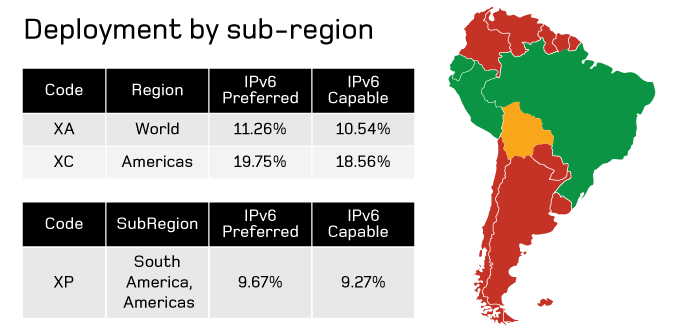IPv6 Adoption in Latin America and the Caribbean in Numbers
29/06/2017

As part of its strategy for the promotion of Internet Protocol version 6, this month LACNIC organized two IPv6 webinars in which more than 145 Latin American and Caribbean professionals participated.
Two technical sessions were held under the slogan Enjoy the IPv6 Experience! While opening the first of these webinars title IPv6 Launch, LACNIC CTO Carlos Martinez reflected on how much the region and the world have advanced in the past 5 years in terms of IPv6 deployment and traffic. “Five years ago, the reality was very different from the one we have today,” said Martinez.
He also presented promising data and noted that a large number of South American countries already have more than 1% of their total traffic over IPv6. Martinez cited the examples of Peru (15-20%), Ecuador (15%-20%), Brazil (15%-20%), Bolivia (4%-5%), Argentina (approximately 3%) and Uruguay (1.3%), all of which have more than 1% of end users with IPv6. “In the case of Brazil alone, 20% means millions of users,” he added.
According to Martinez, the two most interesting cases in Central America are Guatemala (close to 7%) and Mexico (approximately 4%). Likewise, the Caribbean countries that stand out are the Dominican Republic and Trinidad and Tobago, both of which exhibit very rapid growth in terms of IPv6.
“In South America, we have an average of 9% IPv6 users, with some countries far above and others far below this average. Overall, however, this number is in line with the global average,” added LACNIC’s CTO.
In the other sub-regions, Central America, Mexico and the Caribbean, “we need to continue working towards greater growth, as both sub-regions have an average of 1.15% of total users with IPv6, and there are major asymmetries among the different countries,” he added (www.youtube.com/watch?v=HcXDXjBNoxE).
The first webinar continued with two technical talks, the first of which was an introduction to the Neighbor Discovery Protocol presented by Jaime Olmos (University of Guadalajara) of Mexico while the second was titled Security Considerations for IPv6 and was presented by Fernando Gont (Argentina).
The second webinar coincided with World IPv6 Day. During the opening remarks, LACNIC CEO Oscar Robles called for continued efforts to develop IPv6 capabilities because, while these statistics are encouraging, IPv6 traffic continues to be very uneven in the different countries of the region.
Fred Baker then presented IPv6: Where Are We? and Inés Robles closed the webinar with a presentation on the Internet of Things Roadmap at the IETF (www.youtube.com/watch?v=bK5v5cDo0fs&t=4s).
You can also download the presentations here:
http://www.lacnic.net/en/web/lacnic/capacitaciones-agenda